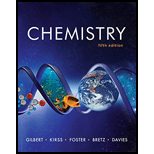
(a)
Interpretation: Odd-electron molecules among the given nitrogen oxides are to be identified.
Concept introduction: A molecule is said to be an odd-electron when the sum of the valence electrons of all the atoms in a molecules is odd that is the total number of bonds formed in a molecule is a fraction.
To determine: If the given nitrogen oxide is an odd-electron molecule.
(a)
Answer to Problem 8.108QP
Solution
The molecule
Explanation of Solution
Explanation
The given molecule is
The total number of valence electrons is calculated as,
The total number of valence electrons in
One bond contains two electrons. Therefore, the number of bonds formed in
(b)
To determine: If the given nitrogen oxide is an odd-electron molecule.
(b)
Answer to Problem 8.108QP
Solution
The molecule
Explanation of Solution
Explanation
The given molecule is
The total number of valence electrons is calculated as,
The total number of valence electrons in
One bond contains two electrons. Therefore, the number of bonds formed in
(c)
To determine: If the given nitrogen oxide is an odd-electron molecule.
(c)
Answer to Problem 8.108QP
Solution
The molecule
Explanation of Solution
Explanation
The given molecule is
The total number of valence electrons is calculated as,
The total number of valence electrons in
One bond contains two electrons. Therefore, the number of bonds formed in
(d)
To determine: If the given nitrogen oxide is an odd-electron molecule.
(d)
Answer to Problem 8.108QP
Solution
The molecule
Explanation of Solution
Explanation
The given molecule is
The total number of valence electrons is calculated as,
The total number of valence electrons in
One bond contains two electrons. Therefore, the number of bonds formed in
(e)
To determine: If the given nitrogen oxide is an odd-electron molecule.
(e)
Answer to Problem 8.108QP
Solution
The molecule
Explanation of Solution
Explanation
The given molecule is
The total number of valence electrons is calculated as,
The total number of valence electrons in
One bond contains two electrons. Therefore, the number of bonds formed in
Conclusion
The molecules,
Want to see more full solutions like this?
Chapter 8 Solutions
Chemistry: The Science in Context (Fifth Edition)
- Draw the Zaitsev product of the dehydration of this alcohol. + I X 5 OH ざ~ TSOH Click and drag to start drawing a structure.arrow_forwardPlease help with identifying these.arrow_forwardFor the reaction: CO2(g) + H2(g) --> CO (g) + H2O (g) Kc= 0.64 at 900 degrees celcius. if initially you start with 1.00 atmoshpere of carbon dioxide and 1 atmoshpere of hydrogen gas, what are the equilibrium partial pressuses of all species.arrow_forward
- Can I please get this answered? With the correct number of significant digits.arrow_forwardDraw the Hofmann product of the dehydroiodination of this alkyl iodide. ☐ : + Explanation Check esc F1 2 3 I 88 % 5 F5 I. X © tBuOK Click and drag to sta drawing a structure. © 2025 McGraw Hill LLC. All Rights Reserved. Te BI BB F6 W E R Y S H Karrow_forwardCan I please get help with this graph, if you could show exactly where it needs to pass through please.arrow_forward
- Draw the condensed structure of 1,3-dihydroxy-2-pentanone. Explanation Check Click anywhere to draw the first atom of your structure. Х C © 2025 McGraw Hill LLC. All Rights Reserved. Terms of use +arrow_forward0.500 moles of NOCl are placed into a 1.00 L vessesl at 700K and after the system comes to equilibrium, the consentration of NOCl is 0.440 M. Calculate the equilibrium constant Kc for the reaction: 2NOCL (g) --> 2NO (g) + Cl2 (g)arrow_forwardWhat is the hydronium ion concentration in a solution of water that has a hydroxide ion concentrationof 1.0 x 10-2 M?arrow_forward
- Identify conjugate acid-base pairs in the following reactions:HBr (aq) + H2O (l) ⇌ H3O+ (aq) + Br- (aq) - OH (aq) + CH3COOH (aq) ⇌ H2O (l) + CH3COO- (aq)arrow_forward4:45 PM Tue Apr 1 K 77% Problem 9 of 10 Submit Curved arrows are used to illustrate the flow of electrons. Using the provided starting structure, draw the curved electron-pushing arrows for the following reaction or mechanistic step(s). Be sure to account for all bond-breaking and bond-making steps. Then draw any missing organic intermediates or products for this reaction. Include all lone pairs in the structures. Ignore inorganic byproducts, counterions, and solvents. :0: H Select to Add Arrows HI CH3OH H+ ·HO CH3OH, H+ 0:0 H H Select to Add Arrows tion Versirate CH3OH, H* Select to Draw Productarrow_forwardCan I please get help with this graph? If you can show exactly where it needs to pass through.arrow_forward
 ChemistryChemistryISBN:9781305957404Author:Steven S. Zumdahl, Susan A. Zumdahl, Donald J. DeCostePublisher:Cengage Learning
ChemistryChemistryISBN:9781305957404Author:Steven S. Zumdahl, Susan A. Zumdahl, Donald J. DeCostePublisher:Cengage Learning ChemistryChemistryISBN:9781259911156Author:Raymond Chang Dr., Jason Overby ProfessorPublisher:McGraw-Hill Education
ChemistryChemistryISBN:9781259911156Author:Raymond Chang Dr., Jason Overby ProfessorPublisher:McGraw-Hill Education Principles of Instrumental AnalysisChemistryISBN:9781305577213Author:Douglas A. Skoog, F. James Holler, Stanley R. CrouchPublisher:Cengage Learning
Principles of Instrumental AnalysisChemistryISBN:9781305577213Author:Douglas A. Skoog, F. James Holler, Stanley R. CrouchPublisher:Cengage Learning Organic ChemistryChemistryISBN:9780078021558Author:Janice Gorzynski Smith Dr.Publisher:McGraw-Hill Education
Organic ChemistryChemistryISBN:9780078021558Author:Janice Gorzynski Smith Dr.Publisher:McGraw-Hill Education Chemistry: Principles and ReactionsChemistryISBN:9781305079373Author:William L. Masterton, Cecile N. HurleyPublisher:Cengage Learning
Chemistry: Principles and ReactionsChemistryISBN:9781305079373Author:William L. Masterton, Cecile N. HurleyPublisher:Cengage Learning Elementary Principles of Chemical Processes, Bind...ChemistryISBN:9781118431221Author:Richard M. Felder, Ronald W. Rousseau, Lisa G. BullardPublisher:WILEY
Elementary Principles of Chemical Processes, Bind...ChemistryISBN:9781118431221Author:Richard M. Felder, Ronald W. Rousseau, Lisa G. BullardPublisher:WILEY





